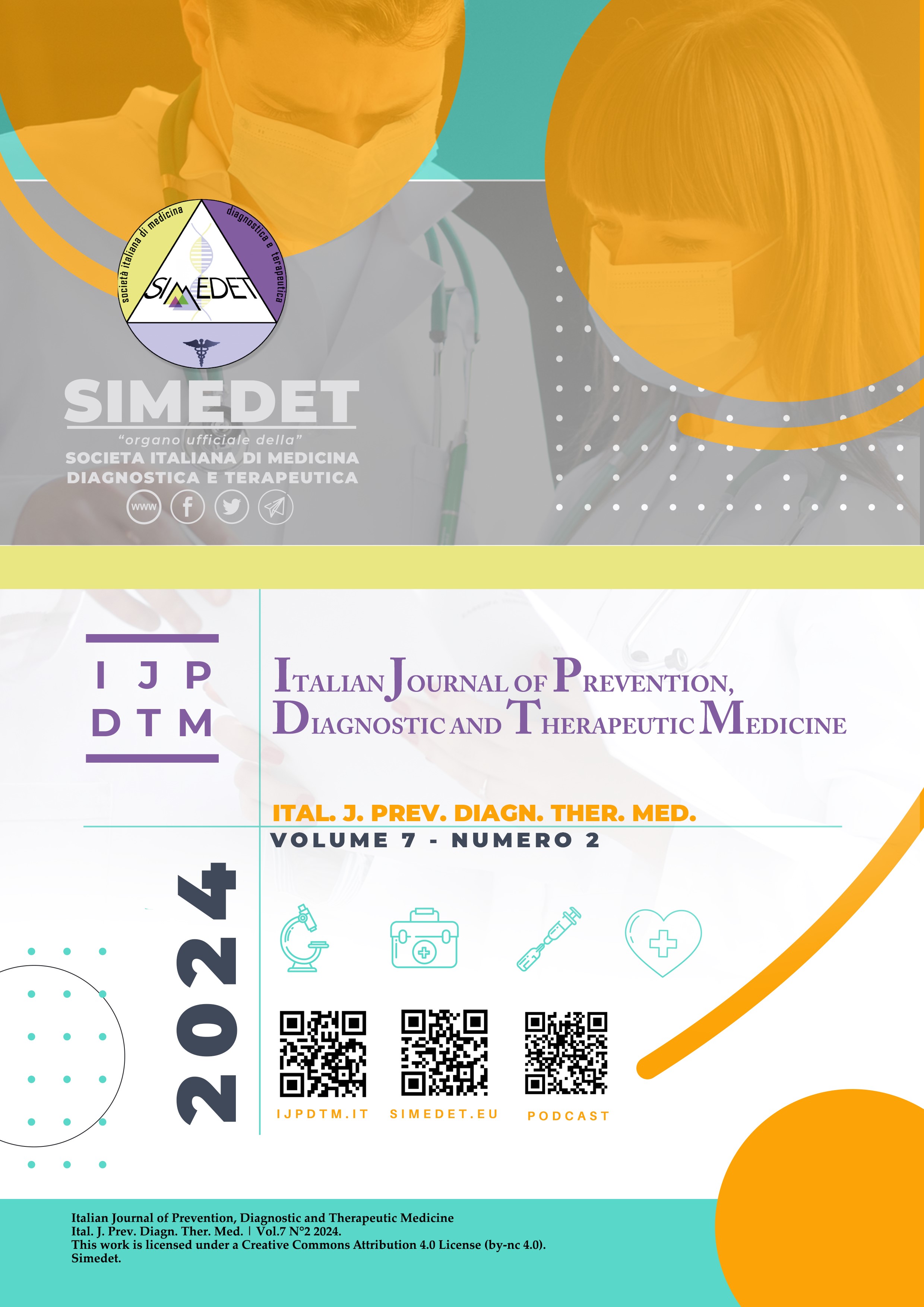qualitative study on the nursing approach to patients with psychoactive substance dependence in acute wards
Main Article Content
Abstract
This study examines the nursing approach toward patients diagnosed with psychoactive substance dependence in acute hospital wards.
While numerous studies in the literature focus on the roles and attitudes of doctors, psychologists, and other professionals, few address the nursing perspective.
Therefore, this work concentrates on how nurses approach patients suffering from substance dependencies, gathering their experiences, emotions, and stories through interviews.
The study’s aim is to identify the actual nursing approach to patients with psychoactive substance dependence in an operational reality where nurses are not specialized in this field.
METHODS:
The qualitative phenomenological method was used, developed through a semi-structured interview consisting of 13 open-ended questions and subsequent analysis with classification and triangulation.
The participants in the study are 15 nurses from the medicine and surgery departments of a Hospital Facility in the Sardinia region (Italy), who have assisted patients diagnosed with substance use disorders during their professional careers.
Participation in the project was voluntary; participants could withdraw from the study at any time.
CONCLUSIONS:
A significant percentage of the sample examined exhibits stigmatization and discrimination in providing care to patients with psychoactive substance dependence.
Through this type of study, it was possible to achieve the set goal, i.e., to investigate the real nursing approach to patients with psychoactive substance dependence.
In response to the results obtained, models are suggested, such as that given by Jean Watson’s Theory of Human Caring, which demonstrates how practicing a holistic approach, based on empathy and active listening, can improve the relationship between nurse and patient.
The proposed study highlights the possibility of attending workshops or free online courses to embrace this theory.
Downloads
Article Details

This work is licensed under a Creative Commons Attribution-NonCommercial 4.0 International License.
References
United Nations Office on Drugs and Crime. Executive summary conclusions and policy implications. World Drug Report, 2019.
Presidenza del Consiglio dei Ministri,Dipartimento Politiche Antidroga. Relazione annuale al parlamento sullo stato delle tossicodipendenze in Italia, 2017.
Stefano Canali. Eterogeneità e numerosità dei criteri nella diagnosi per disturbo da uso di sostanze nel Dsm-5, 2016; https://www.psicoattivo.com/eterogeneita-numerosita-dei-criteri-dipendenza-dsm-5/ (accessed November 2023).
Bonetti, A. Tossicodipendenza e doppia diagnosi: la relazione d’aiuto in comunità, 2005. Franco Angeli.
Kelleher, S., & Cotter, P. A descriptive study on emergency department doctors’ and nurses’ knowledge and attitudes concerning substance use and substance 50 users. International emergency nursing, 2009.17(1), 3–14.
Morley, G., Briggs, E., & Chumbley, G. Nurses’ Experiences of Patients with Substance-Use Disorder in Pain: A Phenomenological Study. Pain Management Nursing, 2015.16(5), 701–711.
Fischer, G., & Eder, H. Interdisciplinary therapeutic approaches with substance abusers taking into consideration gender differences. Wiener medizinische Wochenschrift (1946), 1999. 149(11), 331–336.
Neale, J., Tompkins, C., & Sheard, L. Barriers to accessing generic health and social care services: A qualitative study of injecting drug users. Health and Social Care in the Community, 2007;16(2): 147–154.
Ben Natan, M. B., Beyil, V., & Neta, O. Nurses’ perception of the quality of care they provide to hospitalized drug addicts: Testing the theory of reasoned action. International Journal of Nursing Practice, 2009; 15, 566–573.
DF McLaughlin, H McKenna, JC Leslie.The perceptions and aspirations illicit drug users hold toward health care staff and the care they receive. Journal of Psychiatric and Mental Health Nursing, 25 December 2001.
Kimberly Dion. Injection Drug Users’ Perceptions of Received Nursing Care: A Case Study. Journal of addictions nursing, 2015.
Corley, M. C., & Goren, S. The dark side of nursing: Impact of stigmatizing responses on patients. Scholarly Nursing Inquiry Practice, 1998; 12, 99– 118.
Skinner N, Feather NT, Freeman T, Roche A. Stigma and discrimination in health-care provision to drug users: The role of values, affect, and deservingness judgments. Journal of Applied Social Psychology, 2007; 37, 163–186.
Healy, C. M., & McKay, M. F. Nursing stress: The effects of coping strategies and job satisfaction in a sample of Australian nurses. Journal of Advanced Nursing, 2000; 31, 681–688.
Corley, M., & Link, K. Men patients who leave a general hospital against medical advice; Mortality rate within six months. Journal of Studies on Alcohol, 1981; 42, 1058–1061.
Valentino Sossella. Jean Watson; www.interruzioni.com/ jean_watson.htm (accessed November 2023).
Luciano Pasqualotto, Alessio Cazzin, Emmanuele Perrelli, Mauro Cibin. Terapia e riabilitazione nelle dipendenze: prospettive e strumenti per un approccio di cura integrato e basato sulle evidenze. Educare.it, 2017
Foster, T., & Hawkins, J. The therapeutic relationship: Dead, or merely impeded by technology?. British Journal of Nursing,2005; 14, 698–702.
Mitchell, J. B. Enhancing patient connectedness: Understanding the nurse-patient relationship. International Journal for Human Caring, 2007; 11, 79– 82.
Watson Caring Science Institute; https://www. watsoncaringscience.org/ (accessed November 2023).
Tomas, I. Doppia diagnosi e qualità di vita: le rappresentazioni e il ruolo infermieristico.2018
Clarke, D. E., Gonzalez, M., Pereira, A., Boyce-Gaudreau, K., Waldman, C., & Demczuk, L. The impact of knowledge on attitudes of emergency department staff towards patients with substance related presentations: a quantitative systematic review protocol. JBI database of systematic reviews and implementation reports,2015. 13(10), 133– 145.
Federazione Nazionale Ordini Professioni Infermieristiche (FNOPI). Lo Human Caring nella realtà sanitaria napoletana: risultati di un’indagine conoscitiva sul personale infermieristico attraverso l’uso della scala di valutazione delle cure (Survey 13, CFS-CPV). Rivista l’Infermiere N° 5, 2017

